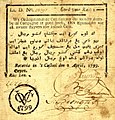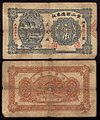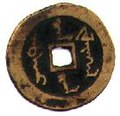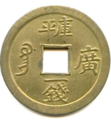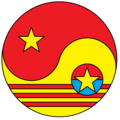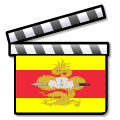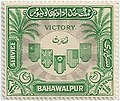User:Donald Trung/Favourites (Donald Trung's uploads)
Jump to navigation
Jump to search
This gallery serves as a collection of the images I like the most in a visual sense that I uploaded myself (not exclusively my own work 🏢), these aren't all my favourites per se, just the ones I tend to look at the most. This gallery has no particular subject or style and will simply include images that I like looking at.
The sole scope of this page is that this is a collection of images that I personally like more. These aren't all of my “favourites” either, just the images I am more likely to stare at in my free time for one reason or another.
Favourites 🌟
[edit]-
Different types of coins that circulated during the late Qing Dynasty, this image singlehandedly demonstrates the transition from the thousands of years of Cash coin-based traditions to that of a decimal currency. It shows a nearly identical coin denominated in “10 Cash” and one in “1 cent” next to each other, as well as cast and machine-struck cash coins.
-
A cast Chinese cash coin (and Mongolian, and Manchu) coin from every major period in Chinese history. As far as I am aware of no similar image existed anywhere on both the internet and the outernet before I created this one. This image alone shows the monetary history of China from before it was even a country until 1912 in a single photograph. 📸
-
This image shows the usage of the old “通寶” coins next to the new copper “元寶” coins. The contrast between brass and bronze show how different copper-alloys were used by the Qing Dynasty under the Guāng Xù Emperor.
-
This image shows a beautiful comparison between 2 (two) “宣統” coins, one is a copper cash coin used by the lower-class masses, and the other a silver 🥈 coin used by the middle- and upper-classes.
-
The last cast cash coin ever next to a French Indo-Chinese/South-Vietnamese banknote issued under the same Emperor showing how the currency system evolved in a mere decade.
-
This image shows 4 (four) machine-struck cash coins from what is today called Viet-Nam, these cash coins while so similar are intricately different in various manners. While one is a zinc coin with a fixed value of 1/600th of a French Indo-Chinese Piastre, right next to it is a traditional “通寶”-type cash coin simply depicting the name of the Emperor, while right above it is a cash coin of 2 (two) Văn (文) with the name “Indo-Chine Française” written in Latin script “1898” in Arabic numerals, and Parisian mint marks.
-
This image is a really powerful one to collectors of Asian cash coins such as myself, the bloke in this image is carrying a lot of strings on his shoulders showing the hard labour of simple transportation of cash coins. The reason all cash coins are holed is to be strung together to be carried like this, and this image was taken in 1917 during the Republic of China (1912-Present) and not Imperial China, cash coins kept circulating in China until the mid-20th century and even though the last Chinese cash coin was cast in 1912, they would continue to be produced in French Indo-China until 1945 and were officially used in North-Vietnam until 1947. Despite the cities adopting more European-style coinage in the late 19th- and early 20th-centuries, Asian cash coins kept circulating in the rural areas long after their production had stopped.
-
This banknote looks like an old artwork but with words on it (I know, that’s how one can describe almost ay banknote… but still.).
-
I personally just really like the colours of this image, and how the Chinese Dragons look reaching out to the wish-granting pearl.
-
This has got to be the most beautiful Qing Dynasty banknote I’ve seen until now, I really like the fact that the coins this banknote is worth is depicted on this banknote.
-
This banknote is of 10 Tiao, prior to discovering this banknote I had the impression that 1 Tiao (吊) equals 1 Chuàn (串) as both terms translate to “1 String (of Cash coins)”, and generally speaking a string of cash coins meant around 1000 (one-thousand) cash coins, so I had assumed prior to discovering this banknotes that banknotes of 1 Diào (吊) and 1 Chuàn (串) both equal 1000 Cash (文), but strangely enough this banknote calculates one Tiao as fifty (50) “Copper coins” (which usually refers to Chinese cash coins in this context). The confusing bit is that many Chinese Republican banknotes tend to use a few dozen different monetary units and rarely note their relationship with each other (unless the more decimal systems are used).
-
Prepare to go through the rabbit 🐰 hole, Alice. While the previous image indicates that 1 Tiao is 50 copper coins, this banknote (from the same province) indicates that 2 Tiao is 98 (ninety-eight) copper cents, or 1 Tiao being 49 (forty-nine) copper cents. This monetary system is highly confusing. 😵
-
I really like this banknote because of it's colours, but also the fact that it depicts a Chinese cash coin (which was presumably the contemporary logo of the Bank of China).
-
A banknote 💴 of 100 (one-hundred) Rubles from the Bukharan People's Soviet Republic issued in 1922. This image shows the emblem (coat-of-arms) of the Bukharan People's Soviet Republic in great detail.
-
Ehhh, but if 16 Tiao is 500 Coppers... That means that 31,25 Coppers is 1 Tiao, how does this system work?! 😵😵😵 Or in other words more contradictory data as to how many Coppers (枚) there are in 1 Tiao (吊), and I can't seem to find any definitive source that states any clear exchange rates, this system is horribly confusing.
-
This banknote is funny because it reads “宣統” (Xuān Tǒng) but was actually brought into circulation in the year “民國十七” (Republic 17) which means that the Kirin Yung Heng Provincial Bank held these Xuān Tǒng-era banknotes for 17 (seventeen) years into the Republic and then just randomly thought “nah, let's bring these old Qing Dynasty bills into circulation and just put a new red stamp on them”, 17 years is a looooooooooong time and the people just accepted this. This also shows the mentality Chinese people had before the Cultural Revolution hit Mainland-China, “the old” was still acceptable and also note 📝 how this banknote is denominated in “Tiao” which is a term usually used for Asian Cash coins which in China stopped being produced in 1912 (the first year of the Chinese Republic), at this time in history only French Indo-China produced Cash coins so the Cash coins that still circulated in the Republic of China at the time must’ve been old Cash coins. China at this point in time was still transitioning and though this change can be seen with the urban-elites, rural-China would remain unchanged until the 1950’s.
-
A banknote issued by the Hupeh Provincial Bank in 1940 that depicts a coin that depicts Spade Money. Coinception.
-
A banknote issued by the United East India Company (VOC) in 1799, this banknote is inscripted in Dutch and Malay (using the Jawi script/Arabic script) and showcases the logo of the United East India Company.
-
A banknote 💴 of 1 (one) Tiao issued by the Huangshan inn issued in 1925, this is the only horizontal banknote denominated in "Tiao's" that I have currently (as of 13 D. 02 M. 2018 A.) that I could find, this shows that the old system persisted in areas where modernisation was in progress.
-
A banknote of 1 Chuàn (串) issued by the Fu Ching Chien Chü Shensi in 1927, Chuàn is another word for "String of Cash (coins)". This banknote was issued 15 (fifteen) years after the last Chinese cash coin was cast.
-
A banknote of 1 Chuàn or 1000 Cash issued by the Chih Kung Money Exchange, T.Y. I do not understand this banknote at all, the Chinese side says that It's 1 Chuàn of wén, the English side (in Latin script) says that it's "One Thousand Cash" but the Arabic numerals on the same side read "100". I really don't understand the nominal value of this banknote 💴.
-
A banknote of 1000 Cash issued by the Ssuchuan Provincial Bank in 1924.
-
The other side of the banknote left of this one, this time it states "100 Copper coins" which means that 1 Copper (coin/cent) is equal to 10 wén/Cash making 枚's equal to 分, at least in refer Province of Sichuan. As denominations seemed to differ per province I can't be certain that this was the exchange rate in the rest of China.
-
A Vietnamese numismatic charm used during Tết, this hanger contains multiple different designs of Vietnamese numismatic charms in one.
-
This image shows a Republic of China (era) banknote 💴 with the text of a law stipulating the Chinese decimal system. Something notable is how the text of this law seems to exclude various denominations like "Chuàn", "Tiao", "Coppers", "Copper coins", Cash, Etc. Which are all used on (much) later banknotes.
-
I saw a shop in Delft, South-Holland where named "Xuemei" and asked myself "Would she sell Chinese numismatic charms?" The answer strangely enough was "yes". When I went there I immediately recognised these Lei Ting curse charms and the Bagua (8 🎱 Trigrams) on the other side, my immediate reaction was to take a photograph... And it failed, so I took a second one and this was the result. 😃
-
These may seem like 3 (three) random coins, but when I zoom in like...
-
These spell out the name of my best-friend. 😜
-
This cash coin actually showcases how Jurchen culture could work without being extremely sinicised, of course most subsequent Qing Dynasty cash coins contained Manchu inscriptions, but this one curiously had not a single Chinese character.
-
This is the type of thing I often run into.
-
And I don't just run into them, this thing actually slapped my face before I realised how it looked.
-
I really like how this brass Guangxu Yuanbao's yellow colour looks, it looks like what I would describe as "daft gold 🥇".
-
This coin beautifully symbolises how the Manchu Qing Dynasty attempted to introduce machine-struck coinage while still being inspired by the old cash coins in their design.
-
A beautiful Guangxu Tongbao (光緒通寶) machine-struck/milled coin that looks as if it's made from gold 🥇.
-
This cash coin beautifully illustrates how the Manchu government of the Qing Dynasty tried to introduce a decimal system where one (1) Kuping Qián is 1/1000th of a Kuping Tael.
-
An extracted version of an image I uploaded to Wikimedia Commons on the main page of the Mandarin Chinese Wikipedia.
-
A Media Markt shop in the city 🏙 of Oldenburg, Lower Saxony shaped like a pyramid.
-
The same Media Markt viewed from the front.
-
That time one of the images I uploaded made the front page of the English-language edition of Wikipedia (1).
-
That time one of the images I uploaded made the front page of the English-language edition of Wikipedia (2).
-
A very beautiful bell 🔔 on a Chinese Republican era banknote issued by the Tah Chung Bank.
-
A very beautiful banknote of "10 Copper Coins" issued by the Chinese Market Stabilisation Currency Bureau in the year 1922.
-
A very beautiful banknote of "10 Copper Coins" issued by the Chinese Market Stabilisation Currency Bureau in the year 1922.
-
A Manchu Qing Dynasty banknote issued in the year 1910 depicting Zeifeng, the second Prince Chun of the Manchu Aisin Gioro clan.
-
An image of a North-Vietnamese banknote imported from Sema's Art-Hanoi website.
-
An image of a North-Vietnamese banknote imported from Sema's Art-Hanoi website.
-
An image of a North-Vietnamese banknote imported from Sema's Art-Hanoi website.
-
An image of a North-Vietnamese banknote imported from Sema's Art-Hanoi website.
-
A very cute gravestone of a young baby girl shaped like a teddy bear 🐻.
-
A banknote issued by the Hua Hsing Commercial Bank (a Japanese puppet bank in China) imported from the website "Banknote.ws".
-
A banknote issued by the Hua Hsing Commercial Bank (a Japanese puppet bank in China) imported from the website "Banknote.ws".
-
A banknote issued by the Tianjin Branch of the Banque Belge pour l'Étranger imported from the website "Banknote.ws". Note that this banknote features the coat-of-arms of the Duchy of Brabant on the left and the 5 (five) races flag of the Republic of China on the right.
-
I (literally) paid € 7,85 to have the opportunity to take this photograph, in fact I drove all the way to Bunde, East-Frisia just for this picture and stopped in other places earlier just to find a Rossmann with this, meanwhile only the Rossmann in Bunde, East-Frisia had it, so this is probably the first I actively spent money since my global lock 🌏🔒 to take a photograph for Wikimedia Commons. Note 📝, that I took this photograph for the (new) Google Pay and Apple Pay payment options which just show how important the internet is becoming for our daily lives.
-
A banknote issued by the China Specie Bank (中華國寳銀行) imported from "Banknote.ws", this banknote features a very beautiful Chinese cash coin design. The cash coin on the banknote features the inscription "中華國寳" (Zhonghua Guobao).
-
A banknote issued by the China Specie Bank (中華國寳銀行) imported from "Banknote.ws", this banknote features a very beautiful Chinese cash coin design. The cash coins on the banknote features the inscription "中華國寳" (Zhonghua Guobao).
-
An e-mail 📧 (notification 🔔) I received from the Facebook in 2014 notifying me that Nokia's Facebook pages would be renamed to reflect the new ownership under Microsoft Mobile Oy. Interestingly enough the general Windows Phone page was also moved from a software-centric page to a hardware-centric one.
-
People counting the votes cast for the European Parliament election inside of the Pekelder municipal office in the Groninger village of Oude Pekela.
-
Two (2) Jiffy (Dutch & Low-Saxon: Nijntje) books in Dutch and in Low-Saxon.
-
A sign of the HoReCa Nederland organisation designed specifically for Chinese restaurants.
-
Googly eyes placed on the Kiosk logo sign inside of the Utrecht Central Station in the year 2019 (two-thousand-and-nineteen).
-
An interesting sign of which I do not know its purpose or why any government would waste money on it (maybe such images are psychologically beneificial???), however I like the colours and the municipal coat of arms of The Hague.
-
A shield with the royal coat of arms of the Napoleonic era Kingdom of Holland.
-
An automatic teller machine operated by the Grenswisselkantoor Travelex in the central train station of the city of Gouda, South Holland.
-
An automatic teller machine operated by the Grenswisselkantoor Travelex in the central train station of the city of Gouda, South Holland.
-
A banknote issued by the Banque Industrielle de Chine imported from "Banknote.ws", I really like the colouring of this banknote.
-
A French Cambodian cash coin produced for the French Protectorate of Cambodia.
-
A banknote of 1 (one) "String of cash coins" from the De Sheng Chang (德盛長) issued in the year Republic 8.
-
Donald Trung's 50.000th (fifty-thousandth) upload to Wikimedia Commons. 💴
-
An image of a private Chinese banknotes (zhuangpiao) from the Bonistika.net website. I really like the photographs of the Pei Yang silver dollar coins on this banknote.
-
An image of a private Chinese banknotes (zhuangpiao) from the Bonistika.net website. I really like the colouring of this banknote.
-
Google eyes 👀 on a public round lamp, I'm honestly glad that people didn't remove them.
-
A banknote of 1 Diào wén (壹吊文, "1 String of Cash Coins") issued by the Tian Ju Heng Money Shop imported from the Yidulive.com website.
-
A Chinese banknote issued by the Beijing Branch of the General Bank of Communications, this banknote is notable for being both vertical (the traditional Chinesestyle) and horizontal (the Europea-style) showing a transition from the traditional Chinese method of banknotes to the international one.
-
Inflationary cash coins from roughly around the same time issued by Joseon, the Tokugawa Shogunate, and the Nguyễn Dynasty. Note that these cash coins cost me (from left-to-right) $ 180,- (One-hundred-and-eighty United States Dollars, down from $ 200,-) for the Sangpyeong Tongbo (常平通寶) of 100 Mun (百文), $ 5,- (five United States Dollars) for the Tenpō Tsūhō (天保通寳) of 100 Mon (百文), and $ 499,99 (Four-hundred-ninety-nine United States Dollars and ninety-nine cents) for the Tự Đức Bảo Sao (嗣德寶鈔) of 60 Văn (六十文).
-
Inflationary cash coins from roughly around the same time issued by Joseon, the Tokugawa Shogunate, and the Nguyễn Dynasty. Note that these cash coins cost me (from left-to-right) $ 180,- (One-hundred-and-eighty United States Dollars, down from $ 200,-) for the Sangpyeong Tongbo (常平通寶) of 100 Mun (百文), $ 5,- (five United States Dollars) for the Tenpō Tsūhō (天保通寳) of 100 Mon (百文), and $ 499,99 (Four-hundred-ninety-nine United States Dollars and ninety-nine cents) for the Tự Đức Bảo Sao (嗣德寶鈔) of 60 Văn (六十文).
-
All denominations of the Sangpyeong Tongbo (常平通寶) series of cash coins.
-
A camera of a smartphone 📱 I might purchase in the future to make better pictures.
-
This image showcases three (3) different Chinese numismatic terms relating to Chinese cash coins, these English-language Wikipedia articles symbolise "the Post-Primaltrek era" of expansions, at this point Wikimedia is no longer "An inferior version of Gary Ashkenazy's (Hebrew: גארי אשכנזי) Primaltrek" locked in some sort of "Primalprison" becoming "A Primalpeer version of Gary Ashkenazy's (Hebrew: גארי אשכנזי) Primaltrek", having imported all (non-image) content from the website, and having now exceeded it with Wikipedia (Primalwiki) articles going deeper into content such as the Daqian, Hongqian, and Zhiqian while having imported content fully about the Bingqian and Zhenkuqian. Content about Chinese numismatic charms and Korean currency are now "mirrored" (except for images) and only coin Hoards aren’t imported.
-
A protective mask with the text "Coronalijer" ("Corona-sufferer"), which is a play on the Dutch term "Kankerlijer" ("cancer-sufferer") often used by MAVO students, in the Groninger village of Oude Pekela, Veenkoloniën.
-
A Xianfeng Zhongbao (咸豐重寶) cash coin of 10 wén issued by the mint of Fuzhou, Fujian.
-
A Xianfeng Zhongbao (咸豐重寶) "Red cash coin" produced by the Aksu mint under the reign of the Xianfeng Emperor. "Red cash coins" (traditional Chinese: 紅錢; simplified Chinese: 红钱; pinyin: hóng qián; French: Sapèques rouges; Uyghur: قىزىل پۇل) are the cash coins produced in Xinjiang under Qing rule following the conquest of the Dzungar Khanate by the Manchus in 1757.
-
An Abkai Fulingga Han Jiha (ᠠᠪᡴᠠᡳ ᡶᡠᠯᡳᠩᡤᠠ ᡥᠠᠨ ᠵᡳᡴᠠ) cash coin issued by the Later Jin Khanate, written completely in Jurchen (Manchu).
-
A bird nest house that was created by several Groninger local governments. It shows how the local governments are trying to preserve the local avian wildlife.
-
A normal image of an old-fashioned security camera 📸 at a petrol station, but a combination of the weather and the background give it a strange dystopian look.
-
A proliferation of shopping cart token coins issued by various major national supermarkets in the European part of the Kingdom of the Netherlands, this image can easily be used to illustrate the different supermarkets in the Netherlands.
-
A proliferation of shopping cart token coins issued by various major national supermarkets in the European part of the Kingdom of the Netherlands, this image can easily be used to illustrate the different supermarkets in the Netherlands. I made this image due to the overabundance of "clutter" in the previous and only included the largest supermarkets.
-
A statue of the Goddess Minerva (Greek: Ἀθηνᾶ) donated to Onze Woning by the Stijlgroep Bewoners 110-Morgen in the year 2010, that is located in the Rotterdammer neighbourhood of 110-Morgen, Hillegersberg-Schiebroek.
-
An image of tape placed on a pole indicating that people should socially distance because of the global SARS-CoV-2 pandemic at the UNESCO world heritage site in the village of Kinderdijk, Molenlanden. This image beautifully showcases "the face of tthe Kingdom of the Netherlands" in front of a global pandemic.
-
An image of tape placed on a pole indicating that people should socially distance because of the global SARS-CoV-2 pandemic at the UNESCO world heritage site in the village of Kinderdijk, Molenlanden. This image beautifully showcases "the face of tthe Kingdom of the Netherlands" in front of a global pandemic.
-
A route sign directing people to a major SARS-Coronavirus-2 testing facility in front of the stadium was originally the Eurovision Song Festival of 2020 was planned. It shows the contrast between planning for the future and having to deal with unforseen events. The site was at one moment planned to be a place where people celebrated international culture and life, but became a reminder of death ☠.
-
A South Vietnamese passport still depicting the Dragon coat of arms of the State of Việt Nam.
-
An envelope used during the State of Việt Nam period, it depicts dragons on the postage stamps reminiscent of the monarchial period of Vietnamese history. This design shows traditional Chinese aesthetic while also incorporating French culture.
-
The bearer's page of a Republic of China 🇹🇼 diplomatic passport issued for Cheng Ching-Wan while traveling to The Hague. The style used inside is still very that of a traditional Chinese document with foreign elements being largely adopted to include additional information.
-
The opening of an Albert Heijn-branded supermarket, the logo is displayed several times in this image and the colour blue beautifully contrasts with the background.
-
The Supreme Ultimate symbol used to represent the division between North Vietnam (the Democratic Republic of Vietnam) and South Vietnam (the Republic of Vietnam) with the Việt Cộng (Provisional Revolutionary Government of the Republic of South Vietnam) in the "Southern field". This image is used to represent the political division of Vietnam following the Geneva Accords with the Việt Cộng shown in the South Vietnamese field as most of the war was fought between them and the RVN on South Vietnamese soil. (Made using Microsoft Paint.)
-
A public rubbish bin with a very beautiful painting on it, that is located in the Groninger city of Winschoten, Oldambt.
-
A Monarchist Vietnamese passport holder incorporating Nguyễn Dynasty period symbolism.
-
A Monarchist Vietnamese passport holder incorporating Nguyễn Dynasty period symbolism.
-
A map of the Provisional Central Government of Vietnam and the Autonomous Republic of Cochinchina with their flags in French.
-
A map of the Provisional Central Government of Vietnam and the Autonomous Republic of Cochinchina with their flags in Vietnamese, written using Chữ Nôm.
-
The flag of The Nùng Autonomous Territory, I really like the contrasting colour scheme and the traditional Chinese elements mixed with the French flag. By themselves I don't really like the coat of arms that much, I think that it looks either "Beautifully boring" or "Boringly beautiful" while I find the French tricolour "too simplistic". However, I really like these two styles combined.
-
The flag of the Vietnamese Constitutional Monarchist League (Vietnamese: Liên Minh Quân Chủ Lập Hiến Đa Nguyên Việt Nam), a Nguyễn Dynasty restorationist organisation based in the United States of America. (Green dragon).
-
The flag of the Vietnamese Constitutional Monarchist League (Vietnamese: Liên Minh Quân Chủ Lập Hiến Đa Nguyên Việt Nam), a Nguyễn Dynasty restorationist organisation based in the United States of America. (Blue dragon). Overall I like the blue Chinese dragon 🐲 design more, however, I miss the "The Imperial Nguyen Dynasty of Vietnam" at the bottom.
-
A 50 (fifty) su (SIC) coin issued by the State of Vietnam, notice how the two Chinese dragons on it resemble the (second) coat of arms of the Nguyễn Dynasty with the same type of tail.
-
A film clapperboard 🎬 depicting both the flag and coat of arms of the Nguyễn Dynasty (to differentiate it from similar flags) to be used on articles about films produced during this period.
-
A commemorative stamp issued by Bahawalpur celebrating Allied victory in World War II (two) depicting the flags of the Republic of China, the United Kingdom of Great Britain and Northern Ireland, Bahawalpur, the United States of America, and the Union of Socialist Soviet Republics. This stamp was issued in the year 1945.
-
A lion carrying the coat of arms of Overschie, Rotterdam.
-
A lion carrying the coat of arms of the Municipality of Delft.
-
My Google Pixel 4A, purchased in late 2021.
-
A product sign stating "As seen on YouTube" where traditionally shops would advertise with "As seen on TV". For someone my age this kind of comes off as "weird" or "odd" as we grew up with television being the dominant medium now seeing it being displaced by the internet.
-
The Vietnamese QWERTY keyboard used on the Microsoft Windows 10 Mobile operating system, this is probably the best Vietnamese-language keyboard out there, unfortunately younger Vietnamese people genuinely think that using the inferior standard American keyboard is better for the Vietnamese language, not because it's easier (because it ain't) but simply because a common sense easy-to-use Vietnamese keyboard "isn't right". At least this is what multiple Generation 8X people told me why they prefer the American keyboard over this version, which is clearly superior.
-
I haven't laughed so hard at vandalism in a while, I really like the way that they subvert a public safety message. Also note the usage of the term "Rijksoverschijt" instead of "Rijksoverheid".
-
The Procès-verbal for the recovery of the items the Bảo Đại Emperor gave to the Democratic Republic of Vietnam during his abdication ceremony. Notice that it describes that Nguyễn Dynasty Sword of the State and Imperial Seal in great detail.
-
A 1920 French Indo-Chinese security report on Nguyễn Tất Thành (阮必誠) giving a sport report on him, his life, and whereabouts. Note that this man would later be known as Hồ Chí Minh (Chữ Hán: 胡志明).
-
An 1890 revenue stamp issued by the French protectorates of Annam and Tonkin (the Nguyễn Dynasty) with a seal affixed to it. Note that the seal reads "Đại-Nam" on its top. This is a good illustration of the early French administration in Annam & Tonkin where the old world of the Nguyễn blended with the modernised French one.
-
A PostNL mailman collecting mail at a mailbox. I just happened to walk past this, this was actually the first time I saw this modern electric bakfiets from PostNL.
-
A street sign for the "Hanoi Street" in Katendrecht, Feijenoord, Rotterdam.
-
The Vijverweg in the Rotterdammer neighbourhood of Kralingen-Crooswijk, Rotterdam Rechter Maasoever.
-
Rich Tonkinese people from the mid-1880's.
-
A man holding a beautiful frame filled with various medals issued by the Nguyễn Dynasty and the French.
-
The flag of the Ukraine on a Dutch windmill during the Russian invasion of the Ukraine.
-
A beautiful contrast between "the modernity" of French Hanoi with a tram riding next to old-style buildings. This shows the slow process of Hanoi transforming from a Nguyễn Dynasty city into Petit Paris.
-
A beautiful young Siamese woman in French Cochin-China in the (Gregorian) year 1902.
-
A 1923 notice issued by the City of Hanoi regarding land requisition to widen the street for the Đồng Xuân Market, notice the usage of Chữ Nôm and the blue "Coat of arms-seals" of the Municipality of Hanoi.
-
An ageing South Vietnamese war veteran holding the flag of the fallen Republic of Vietnam as a sign of loyalty to the idea of his long gone homeland.
-
The South Vietnamese flag flying in front of the Embassy of the Socialist Republic of Việt Nam, The Hague (2022).
-
Hmmm... I wonder what denomination this banknote has. But in all seriousness, this looks like a punishment a teacher would give a misbehaving (naughty) child; "Write 貳貳貳貳貳貳貳貳貳貳!!!".
-
A certificate issued in the year Bảo Đại 3 (1928) by the Đồng tôn tương tế phổ (Hán-Nôm: 同尊相濟譜; French: Association Secours Assistance Mutuels Famille Royale Annam), notice its beautiful design. It combines both beautiful colours with Nguyễn Dynasty period symbolism, it's a shame that this style of document stopped with the abolition of the Nguyễn Dynasty.
-
A Nguyễn Dynasty calendar issued for the year Bảo Đại 19 (1944).
-
A Dutch police officer talking to an older woman wearing a headscarf.
-
A flower pot named "Văn Long" (文龍) during Tết nguyên đán in Hanoi, Tonkin, French Indo-China (1920's).
-
An archaic Zone betaald parkeren sign that was very well maintained. Notice the hand paying with a Dutch Guilder (which were removed from circulation in 2002, while this was photographed in 2023) and receiving an old parking card.
-
A comparison of a Dutch standard passport (nationaal paspoort), Dutch emergency passport (noodpaspoort), and a Dutch laissez-passer (Laissez-Passer).
Original publication 📤
[edit]Sent 📩 from my Microsoft Lumia 950 XL with Microsoft Windows 10 Mobile 📱. --Donald Trung (Talk 💬) ("The Chinese Coin Troll" 👿) (Articles 📚) 17:59, 8 January 2018 (UTC)

















